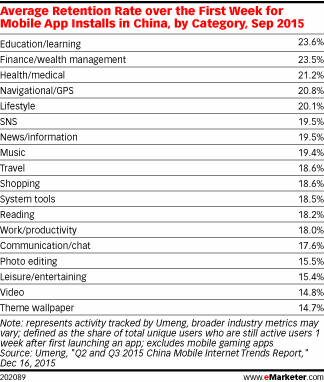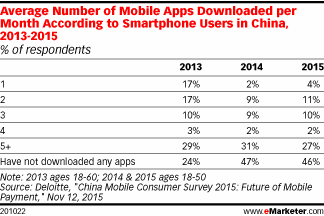China may be the world’s largest app market when it comes to downloads, but new data indicates that those download numbers aren’t translating into loyal users who return to apps on regular basis. According to a report released this morning from eMarketer, citing data from Alibaba-owned analytics platform Umeng, the majority of mobile applications launched in China struggle to retain users. In fact, most apps don’t engage users for more than a week, the research indicates.
The Umeng report, which was based on data from the apps tracked on its platform – the firm tracks 780 million smart devices in China, it says – found that no category of mobile application has retained even a quarter of its users after the first week.
The best-performing apps get close to that number, however. Educational and learning apps retain 23.6 percent of their users over the first week, and finance and wealth management apps do roughly as well, with a 23.5 percent retention rate.
Health apps, navigation/GPS apps, and lifestyle are next in line, retaining at least one in five users one week after they launch.

Apps that don’t do as well are theming apps (14.7 percent retention over week one); video apps (14.8 percent); leisure and entertainment apps (15.4 percent), and photo editing apps (15.5 percent).
Unfortunately for app developers, this trend is not a new one.
Earlier research from Localytics also indicated that Chinese users behave very differently from those in the U.S. Historically, user retention in the country has been worse than in the U.S., but things have been getting progressively worse in recent months, the firm said.
From a report released this summer, Localytics found that user retention in China had dropped from 27 percent to 18 percent of users who would return to an app 11 or more times – in other words, show some form of user loyalty. But the report also found that 37 percent of all users in China used an app only once.
[gallery ids="1254295,1254294,1254293,1254292"]
Localytics offered some speculation at the time as to why user retention is so difficult in China. For one thing, Chinese users spend less time in apps than their U.S. counterparts – only 4.1 minutes. That means that their expectations of what makes an app useful are “dramatically different” and many lead to earlier abandonment, the firm said.
Additionally, the growth and reach of the free messaging app WeChat was also cited as having an impact on retention. That is, many brands are developing on top of WeChat instead of building their own native application. And WeChat’s expansion into other areas – like e-commerce, for example – is decreasing users’ needs for other applications, as well.
Another factor that also comes into play on older devices is that apps are abandoned more quickly due to storage space issues.
eMarketer, meanwhile, also pointed to research from Deloitte as another area of concern for those developers launching apps in China, noting that nearly half (46 percent) of smartphone users had not downloaded any apps at all in 2015. Worryingly, that figure was up from 24 percent in 2013.

However, the good news is that there is something that app developers may be able to do to increase retention – apps that used push messaging had higher retention rates in China. If push notifications were used, abandonment dropped to only 20 percent of users who return to an app once, and retention of users jumps up to 35 percent.
Those numbers are still low compared with the U.S., however, where more than 50 percent of users who opt into push messages return to an app regularly (meaning, over half of users return to an app 11 or more times.)
